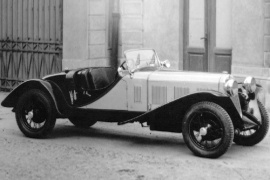FIAT 514 Spider Models/Series Timeline, Specifications & Photos
First production year: 1929
Engines: Gasoline
Body style: Convertible (spider/spyder, cabrio/cabriolet, drop/open/soft top)
Fiat replaced the 503 lineup in 1929 with the 514 model, a vehicle that many historians consider to be the first compact car in history since it was just four meters long. Based on the 514 chassis, the Italian automaker made the Spider, also known as the S-version.
The Italian automaker was highly successful with its fuel-efficient models, and it produced the 514 in three open-top roadster configurations: the S, which is the most common, the MM, designed for the Mille Miglia race, and the 514 CA, which was built for the Copa delle Alpi (Alps Cup). They all shared the same chassis but with slightly different engines based on the same four-pot powerplant and offering different outputs. The car was so successful that the automaker sold almost 40,000 units in just three years. However, many of them sported closed-cabin shapes.
Fiat relied on the car's low weight to get above the magical 100 kph (62 mph) top speed, but it was also considered to make the vehicle aerodynamic. Mind you, the Italian automaker was also involved in the air industry, so it knew a thing or two about airflow. As a result, the 514 Spider featured a slightly tilted rearward radiator placed in a recessed position behind the chassis' endings and between the long and sloped-down fenders. Its 18" wire-wheels were wrapped in 4.5/5.0 tires.
From its profile, the 514 showed a hood long enough to cover the engine and a tilted-rearward windshield that featured two wipers on its upper side. The car also sported short doors and, immediately after them, the rear fenders placed outside the torpedo-style bodywork's main shape. Finally, at the back, the automaker designed a sloped-down tail where the trunk was. Unusually, Fiat stored the spare wheel in there in an era when most automakers mounted them outside, in front of the cabin, next to the engine compartment.
The cockpit could accommodate two occupants: the driver and their side passenger. They both fronted the flat dash panel where the automaker installed the dials in an unusual way. The automaker placed the four-spoke steering wheel and the water temperature gauge in front of the driver, while the side passenger fronted the speedometer, a few other gauges, and a clock. Both occupants sat on the same vinyl-covered bench seat. Among other features of the Fiat 514 Spider, the door pockets for maps and the rearview mirror mounted atop the windshield were crucial in races.
Fiat installed a 1.4-liter inline-four engine in the 514 with the spark plugs mounted on top of the cylinder head. Depending on the version and options, the maximum output ranged between 28 PS (27 hp) and 35 PS (34 hp). In addition, a particular cylinder head built by SIATA in Spain raised the power above 60 PS (59 hp), which was an astonishing specific power output for those times. Power went to the rear wheels via an unsynchronized four-speed manual gearbox with a floor-mounted stick.
